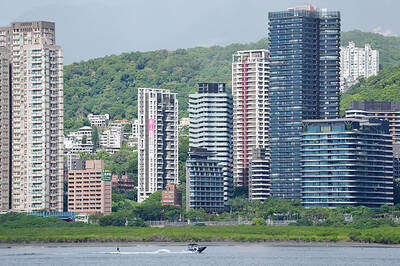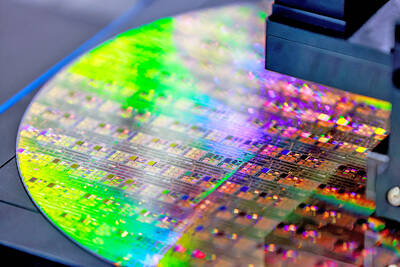A picture of Taiwan Semiconductor Manufacturing Co (TSMC, 台積電) chairman Morris Chang (張忠謀) leaving his seat at the end of a press conference last week while his right-hand man Rick Tsai (蔡力行) proceeded in the opposite direction has prompted many people to wonder if their partnership was over.
That may not be the case at the moment for the two TSMC heavyweights, but it has certainly raised concern about the company’s long-term succession plan, analysts said.
On Thursday evening, Chang unexpectedly announced that the board of directors had appointed him to replace Tsai as chief executive officer, while Tsai was charged with developing green energy business.
The new appointments took effect immediately. Chang retains his position as chairman.
Tsai was appointed TSMC president in 2001 and became CEO in 2005. He has been with the company for 20 years since Chang wooed him away from Hewlett-Packard Co in 1989.
Although few doubt Chang’s ability to run the biggest contract chipmaker in the world, given his past track record and the company’s well-established organizational structure, his displacement of Tsai came as a surprise to many, prompting speculation about the reasons behind the move.
At the press conference, Chang stressed that the appointment of Tsai to lead the new business division in developing solar cells and light-emitting-diode (LED) products was imperative if TSMC is to maintain growth momentum.
He rejected speculation that the management change had anything to do with employee layoffs over the past few months.
Speculation nonetheless remained rife, especially since Tsai, 58, had helped maintain TSMC’s market leadership and profitability during his stint as CEO and was the only Taiwanese on Barron’s magazine’s list of the 30 most respected CEOs this year.
TSMC has long been viewed as a company that is focused on “stability in self-dependent development and in business focus,” authors Liu Tzu-hsin (劉子歆), Chu Yee-yeen (朱詣尹) and Hung Shih-chang (洪世章) wrote in their 2004 research study “Technology entrepreneurial styles: a comparison of UMC and TSMC.”
TSMC’s arch-rival, United Microelectronics Corp (聯電), is best known for its quick responses toward “organizational networks and business diversification,” the study said.
This is arguably a direction TSMC is now moving toward.
“I think the laying off and rehiring of the same employees in a short span is one of the issues. I reckon Morris Chang briefly apologized about this issue a few weeks ago,” Pranab Kumar Sarmah, an analyst at Daiwa Institute of Research (Hong Kong) Ltd, said in an e-mail to the Taipei Times on Saturday.
Sarmah was referring to a televised speech Chang gave on May 20, in which Chang told employees that the company would welcome all of its laid-off workers back on June 1. Chang also apologized for what he said had been the company’s mishandling of its annual employee appraisals, which formed the basis of the layoffs.
In a report issued on March 23 under the title “Kings of the Jungle,” Barron’s described Tsai as “a quieter, calmer executive than Chang.”
The report also praised Tsai for helping boost TSMC’s revenue by 25 percent to US$10 billion since 2005 and, most importantly, for having reached a deal with Intel Corp in March to make the popular Atom processors.
Despite all this, Sarmah said he was surprised by Tsai’s “demotion,” adding that he believed the layoff issue had affected TSMC’s reputation in Taiwan significantly.
“TSMC might have faced pressures from various interest groups, both external and internal, which might have prompted the board to take such a quick decision without having a proper successor,” Sarmah said.
That the position of TSMC president remains vacant has raised concern about the company’s long-term succession plans, Randy Abrams, a semiconductor industry analyst with Credit Suisse, said in a client note on Friday.
“Morris Chang has a long history founding and growing TSMC into a global foundry leader and is well respected in the industry, so we anticipate few issues for TSMC managing quality, customer relationships and foundry operations,” Abrams said.
But considering that Chang is 78 years old and would not be able to run the company indefinitely, the management changes did highlight “long-term questions on the next CEO succession plan,” Abrams said.
Under Barron’s criteria for entering its annual hall of fame, a respected CEO was required to have at least three to five years of experience on as chief executive.
Interestingly, one of the criteria Barron’s used to determine whether someone is a great CEO was to see if their departure would have a significant impact on the company’s share prices.
In Tsai’s case, shares of TSMC declined 3.95 percent on Friday, under-performing a fall of 1.81 percent on the benchmark TAIEX, indicating that investors were cautious about the management transition at the company’s top level.
As it took years for Chang to select and prepare Tsai as TSMC’s second-generation leader before his appointment as CEO in 2005, it could be a time-consuming task to look for a successor, Sarmah said.

Taiwan’s rapidly aging population is fueling a sharp increase in homes occupied solely by elderly people, a trend that is reshaping the nation’s housing market and social fabric, real-estate brokers said yesterday. About 850,000 residences were occupied by elderly people in the first quarter, including 655,000 that housed only one resident, the Ministry of the Interior said. The figures have nearly doubled from a decade earlier, Great Home Realty Co (大家房屋) said, as people aged 65 and older now make up 20.8 percent of the population. “The so-called silver tsunami represents more than just a demographic shift — it could fundamentally redefine the

The US government on Wednesday sanctioned more than two dozen companies in China, Turkey and the United Arab Emirates, including offshoots of a US chip firm, accusing the businesses of providing illicit support to Iran’s military or proxies. The US Department of Commerce included two subsidiaries of US-based chip distributor Arrow Electronics Inc (艾睿電子) on its so-called entity list published on the federal register for facilitating purchases by Iran’s proxies of US tech. Arrow spokesman John Hourigan said that the subsidiaries have been operating in full compliance with US export control regulations and his company is discussing with the US Bureau of

Businesses across the global semiconductor supply chain are bracing themselves for disruptions from an escalating trade war, after China imposed curbs on rare earth mineral exports and the US responded with additional tariffs and restrictions on software sales to the Asian nation. China’s restrictions, the most targeted move yet to limit supplies of rare earth materials, represent the first major attempt by Beijing to exercise long-arm jurisdiction over foreign companies to target the semiconductor industry, threatening to stall the chips powering the artificial intelligence (AI) boom. They prompted US President Donald Trump on Friday to announce that he would impose an additional

Pegatron Corp (和碩), a key assembler of Apple Inc’s iPhones, on Thursday reported a 12.3 percent year-on-year decline in revenue for last quarter to NT$257.86 billion (US$8.44 billion), but it expects revenue to improve in the second half on traditional holiday demand. The fourth quarter is usually the peak season for its communications products, a company official said on condition of anonymity. As Apple released its new iPhone 17 series early last month, sales in the communications segment rose sequentially last month, the official said. Shipments to Apple have been stable and in line with earlier expectations, they said. Pegatron shipped 2.4 million notebook